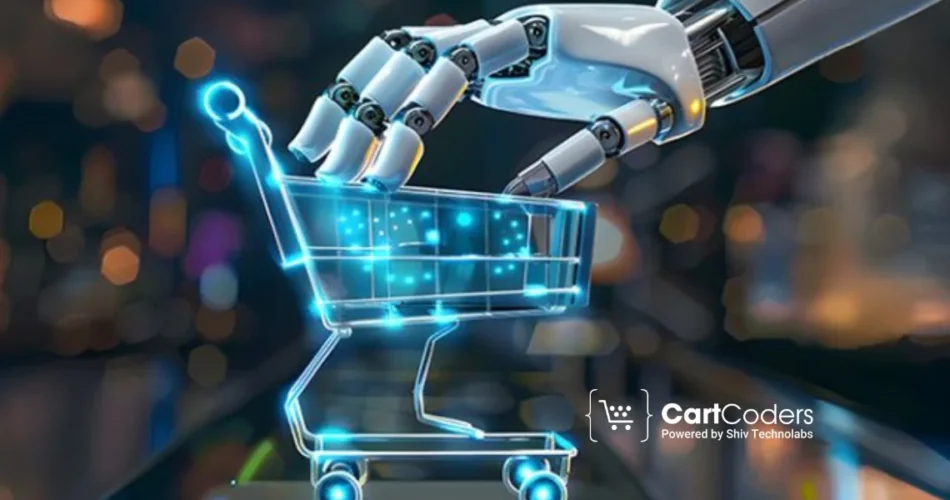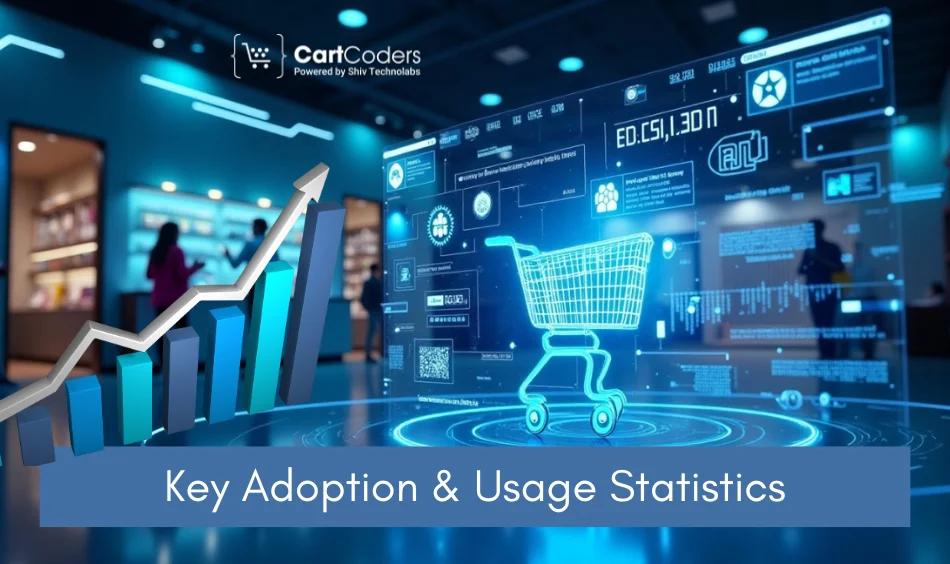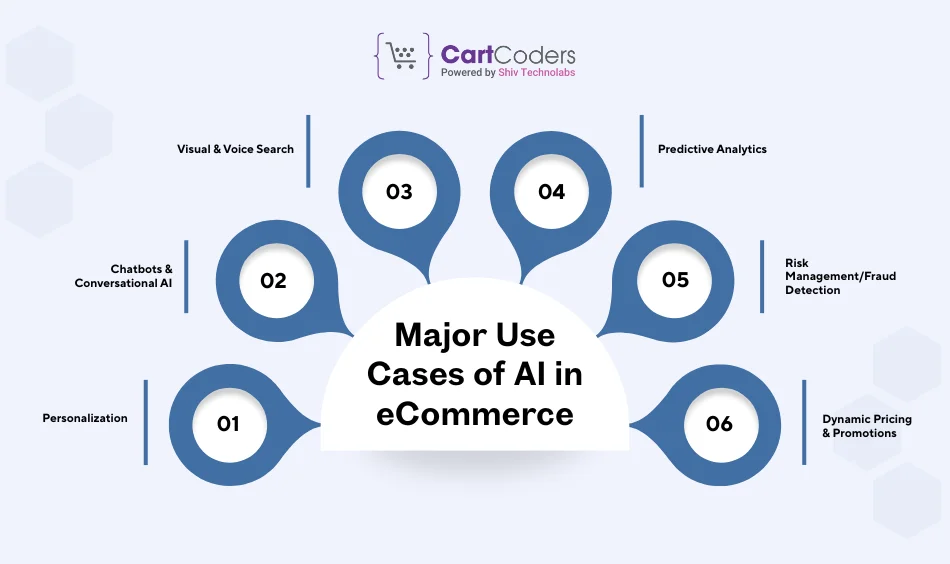Custom Engagement Solutions
Unlock tailored solutions with a free, no-obligation strategy session.
Expert Developers & Engineers on Demand
Scale Your Team with Skilled IT Professionals
Expert Guidance for Digital Transformation

Artificial intelligence is transforming ecommerce from a gimmick into a growth engine. With AI in 2025, it will not only automate but will also remove friction, increase the number of conversions, and personalize experiences on a large scale.
Retailers utilize AI in product suggestions, intelligent search, dynamic pricing, and chatbots to enhance customer satisfaction and increase lifetime value.
In this article, we will examine the global AI in eCommerce market value and growth expectations, recent adoption rates, motivations, and key challenges.
We will begin with the macro-level: what is the current size of AI in eCommerce, and how is it evolving?
The AI in the eCommerce market has been increasing in recent years. The valuation of the AI-enabled eCommerce segment is expected to increase to $17 billion by 2030. Adoption and investment surged in 2023, with more retailers transitioning pilot projects to production.
Sellers Commerce predicted that in 2025, the market of AI in eCommerce will grow to USD 8.65 billion which corresponds to many industry predictions. Another prediction from DemandSage is USD 9.01 billion in 2025, characterised by a robust compound annual growth rate (CAGR).
Greater projections are even more ambitious. Research estimates that the AI market will reach $64.03 billion by 2030. Other sources predict slightly different curves, although they all tend to the exponential expansion.
Other market forecasts of AI-powered eCommerce solutions have a lower value: $31.43 billion in 2034, with a CAGR of approximately 16.5% beginning in 2025.
According to reports, the majority of items cannot be purchased on Amazon because they are manufactured by companies not affiliated with Amazon. It is reported that most products are not available on Amazon because they are produced by companies unrelated to Amazon.
Regional Breakdown
These are regional patterns of disparate infrastructure preparedness, regulatory settings, and capital availability.

By understanding how retailers are already utilising AI, one can gain insight into the actual opportunities that exist.
According to a recent survey, 89% of companies are currently using or testing AI in their eCommerce operations in 2025. Moreover, many companies have shifted from experimentation to practice: as of 2025, 77% of eCommerce specialists incorporate AI into their daily operations.
However, adoption is not equally spread: according to some studies, only every 40th respondent has active use cases of AI; most of them are in pilot or evaluation stages. In 2010, more than 450 million users subscribed to Facebook, a figure that continued to increase as the company introduced Facebook pages, a popular feature on the Platform
The most generally used AI capabilities in eCommerce are:
Master of Code states that now many major retailers incorporate AI in form of product recommendations, search optimization, and customer support robotics.
Impact Numbers
Combined, these statistics form a picture: AI is no longer experimental; it is providing the business lift that can be measured.
What is driving AI in eCommerce – and what is stopping it?
These frontier tools bring AI usage to new customer touchpoints.
These are significant obstacles that retard wider adoption.

The following are the top practical applications that will create value in the present-day world.
The AI features come with a stack of technologies, data pipes, and metrics of evaluation behind them.
To feed all this AI machinery, the information is required to flow smoothly: out of eCommerce platform logs, user behavior, inventory systems, CRM and so on. The choice between cloud versus on-premise implementation affects the latency, cost, privacy and performance.
You would like to watch and streamline:
CartCoders is best online store development company with capabilities to implement advanced AI integration to ensure that our solutions meet your end to end store requirements.
Our team always stays on top of the trends, which allows us to develop top-class online stores. At CartCoders, we can develop store with great interfaces with future ready capabilities.
We guarantee our tested ROI, shorten the implementation time, and provide dedicated support teams. We have already done so in the case of physical stores, and we are familiar with how AI integrates with commerce. CartCoders does not mean creating AI in a vacuum – your AI operates in your store.
Best Practices for Implementing AI in Your Store
These are principles to guarantee success in embracing AI.
AI is no longer a trend in eCommerce, as it is driving tangible growth, effectiveness, and a better customer experience. As the eCommerce market size for AI globally expands into tens of billions of dollars, and the trend of adoption shifts to a pilot stage, artificial intelligence in eCommerce is becoming the norm.
CartCoders is the best online store development company specializing in developing feature rich online stores that ease the store interface making it easy for customers to buy. Our team of development experts design eye catching store set to minimize cart abandonment. Contact us today to develop a feature rich store with impressive functionality.
The various projections by 2025 show the AI in eCommerce market will be about USD 8.65 billion in the market as more companies continue to adopt and invest in personalization, chatbots, and analytics.
A CAGR in the range of 24-25 percent between 2024 and 2034 is estimated in many sources with some less optimistic projections of 16-17.
The most popular ones are chatbots and conversational AI, recommendation engines, visual and voice search, predictive analytics, fraud detection, and dynamic pricing.
Depending on the extent to which AI is incorporated into UX, the stores usually experience a 5-15 percent improvement in such key metrics as average order value, conversion, and retention.
The problems are data quality, integration complexity with the legacy systems, expensive nature, in-house AI knowledge, and compliance or privacy.
The classical AI models react or foreshadow depending on patterns. Generative AI literally writes original content (descriptions, creative copy, imagery) that can be used in the process of catalog writing or creating ads or scaling content.
You require clean customer, product, and behavior data; a scaleable eCommerce platform; an understanding of what AI features you desire initially; and the desire to test, iterate, and invest in infrastructure.
Look for development teams like CartCoders with expertise in ecommerce development and work on AI powered stores. Do check their previous work to analyze their expertise in store development.
Projects delivered in 15+ industries.
95% retention rate, building lasting partnerships.
Serving clients across 25+ countries.
60+ pros | 10+ years of experience.